
It is one thing to vision a positive future, it is another to know the steps and feel empowered to get there. The different aspects of design given in this chapter are tools for us to use in design work and provide us with varied ways of achieving insights. The design web in the last section provides a cohesive framework for attaining our goals.

Design can seem like an exclusive word, something that we somehow have to be trained to do. On the contrary, we are all innate designers. When I ask the question on courses “who has designed something before?” only a few will say they have. I then ask who has planned the layout of their living room. Mostly everyone has at some time and they use criteria such as the resources they have, flow of people through the space, activities in the room and the location of certain items in relation to others, such as sofa and fireplace. All these factors are taken into account on an intuitive level and a design or plan arises. This type of designing is known as black box designing – where the process is not transparent. Our lives are filled with design opportunities from planning our day to running projects, organising fitness programmes to revision timetables. Most of these we do without recognising ourselves as designers.
From understanding nature’s lessons of principles, systems and patterns we have already increased our ability to make more informed decisions and lifestyle choices. Permaculture design is an open box framework that pulls these all together in methodical steps towards our goals.

Designing is like planning a journey; we are more likely to get there if we know where we are going. The more information we have, the more effective the expedition. When our design is a transparent process we are able to engage others. It saves us time, energy and mistakes. By applying a step-by-step method and organising ourselves we can minimise any feelings of overwhelm. A design can inspire action and be a vehicle for manifesting our visions.
In its simplest form design has 3 steps:
There are of course complexities to add to this picture that we will come to in due course. When travelling we would research the costs and time implications of the different options and who our companions might be. We might listen to the radio as we drive to check on traffic jams and choose an alternative route. We could have contingency plans in place for delays.
Observation is an on-going process throughout design and in life. It is essential for us to observe so that we know where we are, what effect changes have had and how we and other people are feeling. Observation widens our awareness and happens through all of our senses: seeing, listening, feeling, tasting and smelling.
It is easy to look without seeing. Watching the world zoom by from a moving car or in miniature behind a television screen, we can forget how to see the detail and observe in wonder like a child. How can we see the patterns in nature, or the person behind the face? How can we reflect on our own progress and be open to feedback?
Most of the time when we see we also interpret, we make assumptions that lead our thinking. Can we perceive like a child? As if we don’t know the story behind what we see, as if we don’t know the creature buzzing from flower to flower is a bee collecting nectar to make honey, or that the yellow flower will turn into a puffball of seeds to float on the wind. It is a skill to see our observations in the present, without imagining the past, predicting the future or thinking we know the outcomes of our adventures: to see without judging or thinking what we see is static, true or unchangeable. It is important for us to think about how, what and why we observe at the outset. The initial observations are necessary for us to tune into what is going on. It is essential to start our journey knowing where we are. Through these observations we can gain a deeper understanding of what is needed with the design. Slowing down and opening our eyes and ears begins the process. A useful skill to develop is the ability to stand back from what is happening and just observe. Putting our judgements and assumptions to one side enables us to perceive more fully, with objectivity and perspective.
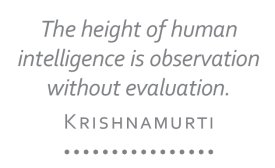
One of the challenges we may encounter both when we are designing for ourselves and for others, is that initially when we open up to observing what is going on, we can become aware of a problem previously hidden from view. When we bring it into focus this may provoke feelings of guilt or embarrassment. Other people may be annoyed with us for allowing the problem to get so bad. It may seem like a step backwards at first and we feel like we are worse off because we now know how bad things are. However, in the long run it is an entirely necessary step.
As we progress in the design, observation allows us to receive the necessary feedback from our actions. We can plan specific times when we stand back from our work and reflect on our progress. We can mark milestones or have regular times to check–in, like taking a photo from the same spot every month to see the change in the garden. Through conscious observation we may see changes that might otherwise be invisible to us.
During the process of designing we can be observing ourselves (and others) by asking ‘How do I feel?’, ‘What’s going on inside of me?’, or ‘What are my energy levels?’.
Observation is as much about paying attention to the periphery as focusing on the centre. Seeing who is being left out of discussions, what’s happening at the edges of the day in my family, where thoughts are wandering off to… These will provide us with useful information, and perhaps point us to a problem on the horizon that we might then be able to avert.
If we don’t take time to observe, we are in danger of heading off in the wrong direction, trying to fix something that isn’t broken or neglecting what needs attention. We miss important clues as to what is appropriate, and simple ways to improve the quality of the lives around us. By observing where our energy leaks are, we can design ways to improve the channels for energy, flowing to a bigger vision.
When we begin our design we cannot predict what the emergent properties might be, like forming a band and getting a magical sound. Keeping open to observation allows us to be responsive to this.
Biotime diaries are a way of collecting observations that allow us to look for patterns. Recording observations over time will give a better insight into why things are the way they are. While we are recording the data we do so as objectively as possible: without assumptions, judgment or manipulating the information. We can try not to make assumptions about why things happen, and look for relationships at a later time.
Biotime diaries were originally used to note natural phenomena, such as rainfall, temperature, the day the first daffodil came out or the last frost of the year. If this data is collected over a period of years it can be used for comparisons. Expressions such as oak before ash, you’ll get a splash, ash before oak you’re in for a soak, arose from making the connections between which leaves come out first and the rainfall that summer.
If you use biotime diaries for yourself on a daily basis, you can note your energy levels, the food you eat, the quality and quantity of sleep, your moods, concentration, confidence or any other factors that are relevant to you. You might want to note the quality of interaction with family or friends. Find a simple way of recording these, so that the diary is easy to maintain. After time this can start to show connections between things both internal and external that we may have not previously linked.
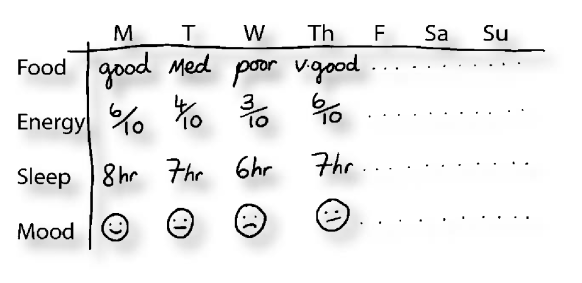
Gary Finch, a permaculture teacher, started a biotime diary as part of a design for his own life while doing his permaculture diploma. He records the feeling he had when he woke, the quantity and quality of food, exercise, mind–body activities such as tai chi, his energy through the day, the amount of water he drank and concludes with his thoughts for the day. He also notes any excessive consumption, things he is not doing, zone 00 activities and anything towards any of the three ethics. Not wanting to do all of this every day, he decided to do it every nine days, so that he would not incur any bias from doing it the same day of the week.
After doing this for over a year he has noticed various connections between his eating and exercise patterns and energy levels. For example, when he eats sandwiches for lunch he has less energy during the afternoon and after work than if he eats just fruit during the day. He has observed that when he keeps properly rehydrated through the day his energy levels are better and his emotional health is more balanced. He has also been able to observe that the amount of exercise he has is more influential on his energy levels than the amount of sleep.
He has recently evolved his system and is now recording observations with the phases of the moons, rather than every nine days. This is easier to remember and he is hoping to get interesting information about how he is affected by the moon cycles and the seasons. He records them on A4 sheets, which have space to record four years’ worth of information on them, so he will be able to compare one year to the next, enabling him to identify bigger cycles within his life.
He says, “Doing the diary has allowed me to put theory into action. I can observe my habits and the impact they have on my life. I record what happens if I change my behaviours. I can then make choices about what I do and take self-responsibility. If I am feeling low I can think about why this might be. I have enjoyed making observation a habit in my life.”
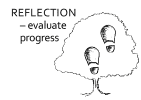

Keep a diary for a week recording your energy levels on a scale of 1–10 in the morning, afternoon and evening, and the food that you have for breakfast, lunch and dinner and any snacks. You may want to add other relevant information, but not more than you can manage to record for the week.
At the end, have a look back over the week and see if any patterns or connections emerge. You may decide to continue this and add further information.
Our aim in permaculture is to turn spirals of erosion into spirals of abundance and productivity. This can be applied to human systems as well as natural ones.
All around us we are faced with problems: little ones, big ones and ones that can seem insurmountable. The world is becoming more and more complex around us and we can feel smaller and smaller in the face of it all. One of the ways of identifying what is happening around us is to think in terms of erosion. Erosion is usually associated with natural resources such as soil, but it is the gradual destruction, reduction or weakening of anything. It describes something that has been useful becoming less useful.
Not all of these things are eroding everywhere, but generally around us we can see erosion of:
Some of these things could be regained with the right strategies and resources; others will be lost forever.
We don’t usually just wake up one day and find a big problem that needs solving. More often than not there is a gradual worsening of the situation. This slipping away from the richness there once was taken for granted or only perceived from the periphery. There can be a major event in our lives or in the news that brings loss to our full attention but it generally doesn’t come from nowhere, there has been a build up of circumstances.
Problems interact with each other in the same way systems do. To make effective change we need to know the cause of the problems. This is a far more complex issue and sometimes we may be looking at the symptoms rather than the causes. Some factors initiate the erosion and others just perpetuate it; the effect is cyclical. These are known as spirals of erosion or vicious cycles.
Each revolution of the cycle returns us to a place slightly worse than the last. With this spiral of apathy, the overall health, energy, confidence and self-esteem of the person are being eroded.

Here is a simple spiral that is likely to have many further offshoots. Alcohol abuse, violence and depression could all come into the picture and have further ramifications. The negative effects are cumulative with each cycle. These spirals can become routine; one thing follows another and we come to the same place, making a pattern of behaviour, which we keep following as we are creatures of habit.
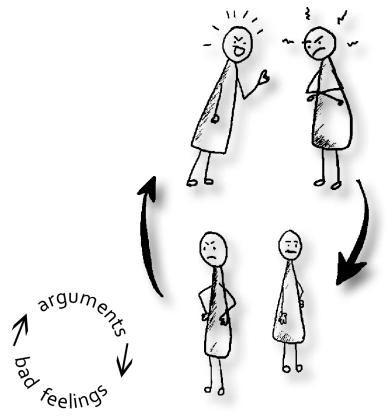
There are larger scale spirals of erosion as well. One in society is

Globally we see the spiral of

When we experience a headache the pain is actually the external symptom and not the root cause. The headache could be caused by too much sun, dehydration, stress, an allergic reaction, or a much more serious problem. Taking a headache pill may mask the pain and provide relief but this only treats the symptom. Looking for the root cause and treating this could provide relief and prevent the problem reoccurring.
What we would all like in our lives are spirals of abundance where each time we go round the spiral, our well-being and productivity increases. The accumulation of yields provides further momentum and there are knock-on benefits creating further spirals of abundance.
The spirals of erosion opposite could look like this if they were turned to spirals of abundance.
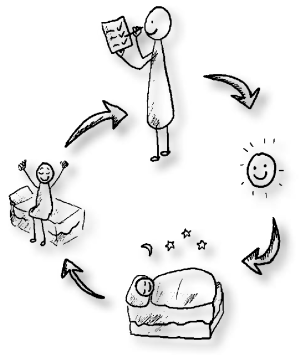
The spiral of apathy turning to a spiral of achievement:

The spiral of arguments becoming a spiral of communication:

From these positive feelings we would be able to grow and develop and give to others in our lives.
My friend Caroline Molloy created a spiral of abundance in her life. It began with a conscious decision to become healthy and creative which led to her being open to learn about permaculture. This provided a community of like-minded people who further supported her to become more healthy. This pathway has led her to training to become a permaculture teacher, bringing the skills from her previous work in the trade union movement.

We have identified the erosion that is occurring and the abundance we would like to have; we now need to think about how to turn one spiral into another.
The first time I felled a tree my first reaction on trying was 'no way have I got the brute force needed to do this'. Luckily my chainsaw teacher was on hand, not for any physical help but to guide and reassure me that it was achievable – by me – I just needed to find the ‘sweet spot’; the point at which it was possible. By finding the exact position and using the momentum of the tree rocking back and forth to do the work for me I was able to bring the tree down without breaking my back. Likewise to break these spirals of erosion we need to find the ‘sweet spot’, the point at which we can intervene and start to turn the spiral. There are also likely to be places where it is particularly difficult to break the spiral; for example trying to stop it dead in the middle of a blazing row is likely to just inflame the other person more! Attacking the root of the problem is ideal in the long run but it may be advantageous to soften other places first.
Just as I used the energy of the tree rocking to bring it down, we can use the energy of the spiral to transform it: after an argument, when everyone has cooled down you can use the situation to express true feelings and come to a deeper understanding.
After observation we can think of many ways and places that could be turning points, and evaluate which ones seem appropriate for the people and the situation. It may be that two or more could be used simultaneously.
Each of these actions either deflects one of the stages of the spiral of erosion or provides us with a link to the spiral of abundance, or both.
Turning a spiral of apathy into a spiral of achievement:
Turning a spiral of arguments into a spiral of communication:
Observing and identifying spirals of erosion in our lives is the first step to turning them around. Sometimes the spiral turns slowly and we may not even be aware of the gradual effects that are occurring. Keeping a biotime diary will help to build awareness.
From identifying points of intervention we can then use other design methods to identify resources and opportunities that can aid us. These points of intervention may not be immediate fixes; like with felling a tree, there is some rocking back and forth and it can take a while before it is committed to the change. Our actions may initially just slow down the spiral; for example there could be longer gaps between each argument. This application of the brakes allows us to put more things in place to further turn the spiral. Conversely sometimes a little nudge in the right direction can be all it takes to turn it around.
We have done the three steps of design:
We can design ways to transform our problems into spirals of growth, regeneration and well-being in all aspects of our lives.
The next complexity of design arises in making the steps to achieve our spiral of abundance. There are likely to be things that stop us from immediately making the interventions. Limiting factors are any leaks or blocks in the system that slow us down or stop us getting where we want to get to. Anything that limits growth and productivity can be called a ‘limiting factor’. Where is the dripping tap? Where could the energy flow better? It is through identifying limiting factors that we can assess which areas we need to focus on in our design. The leaks need to be plugged and the blocks overcome.
Limiting factors can be physical or invisible. When we are thinking about land it is easy to identify physical limiting factors: climate, soil, size of land and aspect all affect the productivity and dictate the foci of the design. The invisible limiting factors often come from the people who are gardening on the land – their energy, skills or communication within the group. External limiting factors might include red tape from officials, land tenure or planning permission. Both external and internal limiting factors need to be identified and resolved.
Money and time are the most often mentioned limiting factors. “If only I had the money I would…” “I don’t have the time to…” While this may be true in many cases there are also many situations where it is not time or money that is the fundamental thing stopping us, but confidence, motivation, skills, support, inspiration, momentum, processes, moods or space.
Until the base limiting factors are addressed we may move forward but not as much as we would like. We sometimes fix one higher up and wonder why things are still not shifting. Like a leaky barrel, we need to address the lower-down limiting factors to stop the energy leaking out and make progress. If we manage to access money but time is still limiting us we could look at how we could use this resource to minimise our time constraints, for example by employing someone or paying for childcare.
It is the invisible limiting factors that often slow us down the most, mainly because of our blindness to them. Within relationships, work places and any groups there are invisible limiting factors such as communication, decision-making processes, group dynamics and conflict that greatly diminish effectiveness. There may be other distractions that limit us by upsetting our focus and pulling us off course. Honesty is needed to identify all the limiting factors. When we know them, we can design ways to work around them or to minimise their impacts.
Limiting factors are not static, they can change over time. In the garden they can change seasonally: in the spring we can be limited with the number of pots we have to sow seeds; in the summer water can be our limit; in the autumn we can run out of space; in the winter sunlight and warmth limit growth. They can change more quickly than this as well.
Limiting factors are like strengthening the weakest link in a chain – another link now becomes the weakest one – or peeling back the layers of an onion, another limiting factor appears, and it may make us cry!
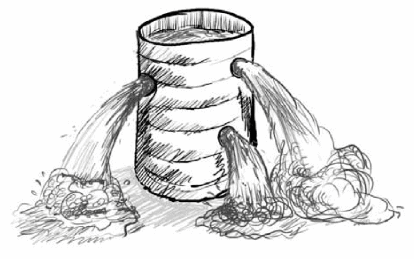
When we do a risk assessment for an activity it is not to deem it too risky to do but so that we can work around the risks and find strategies to deal with them if they happen. Likewise the aim of identifying the limiting factors is not to shatter our confidence or motivation for doing the project but to build in ways to dissolve them or lessen or remove their impact. We don’t need to develop a preoccupation with our limits.
When we have established what the limiting factors are, these then become the foundations – the building blocks for design. The more candid and explicit the limits are the more real the solution is. The aim of the design is to minimise, side step or negate altogether the influence of the limiting factors to allow more potential for growth and productivity.
When friends, Helen and Jim Morris-Ridout were building their home there were plenty of opportunities for them to confront their limiting factors and design around them. Helen reflected, “Without our training in permaculture we may well have given up at times. But we knew there were solutions to every problem we encountered and we just had to find a way around them.” One of their biggest limiting factors was the challenge of how to balance family life and still make progress on the building. Jim said, “For me it wasn’t an option to either not see my children or to not get on with creating our home, both had to happen.” He resolved this by finding jobs that he could do with his sons around and teaching them safe ways of using tools for themselves. His eldest son loves carpentry and is more proficient with tools then most seven year olds.
| Scenario | Limiting factor | Design needs/solutions |
|---|---|---|
| Community garden | Money | Fundraising, selling plants |
| Exercise routine | Motivation and stamina | Get friend involved for company |
| Wanting promotion at work | Not getting along with your boss | Developing relationship with boss |
| Community group | People to get involved | Awareness raising event |
| Transition town group | Group dynamics | Effective meeting techniques |

Everyone will have their own limiting factors. Some examples may be understanding, time, lack of confidence, motivation, seeing the relevance or resistance to change.
There may be things inside of yourself or external influences pulling you off in a different direction. Dig a bit deeper here and ask yourself – what else may get in my way? There may be concerns that you have about change that are underlying your resistance. Or it could be practical considerations such as reading the book in bed at night.
Look back at your aim for reading this book and think about what could stand in the way of you reaching it.
For each of the limiting factors and concerns think of at least one way in which they could be worked around. Then decide which strategies you could put in place now, and which ones you can use later if and when you need to.
Zoning is a conceptual design tool used for managing our own energies. Radiating out from the centre are zones zero to five. Zone 00 is the self at the centre. On a land based design, elements that are in need of most attention are placed nearer to the home and yourself than those that need less frequent attention. Placement varies according to how often they need visiting or how often we need to visit them, with those that need to be checked every day closest to ourselves, saving us energy. Zone 0 is our home, zone 1 is the immediate garden, 2 and 3 would be main crops that need less harvesting and maintenance and larger areas of pasture. Zone 4 is managed woodland. Zone 5 is the wilderness zone that we would only visit to learn lessons from nature and not to interfere.
In our homes or office we can use this concept on a smaller scale to assess our energy flow. The idea is that items closer to where we need them will get more attention paid to them. Just as we water plants more frequently that are right outside our back door, urgent and important tasks are more likely to get done when within our sight. If we want to play the guitar more, having it close to hand will make it more accessible. Conversely we can relocate items to a further zone if we want to focus less on them.
For instance we will reach for chocolate biscuits less often if they are on a high shelf out of the way than if they are right next to the teapot. Having to actively get the TV out makes us pause and think about whether we actually want to watch something or are turning it on out of habit.


Think of two things in your current lifestyle, one that you would like to do more of, and one you would like less of. Now think about where these things are in relation to you and your movements through the day. You may have the answers already, or perhaps you need to observe yourself over a few days.
Whatever you would like less of is a distraction that you can remove or distance. If this isn’t possible find some barrier, or way of making it more difficult to get to; this could be as simple as a cloth over the television. This is a way of breaking our patterns of behaviour.
To test this theory out, move something from one of the cupboards in your kitchen that you use frequently; this could be the oil for cooking, wooden spoons or the tea jar. Over the next few days observe how often you open the cupboard it was in to reach for it without even thinking. (You may want to let your other house members in on the experiment as they will also be reaching into the same cupboards and may get annoyed!)
Now, think about what you would like to encourage in your life, reading, playing music or eating healthy snacks. Where can you place these so you can visit them more easily?
Zones can also help us to map out our connections with other people in our lives. Each zone has defining characteristics, although they are not fixed and do not have distinct edges.

Which zone people are in, shifts over time. People are not always in the zone you would like them to be; some closer and some further away. How we manage our relationship with these people may depend on which zone they are in. Our range of peoplecare skills and ability to relate to people within each zone varies. Some of us have compassion and understanding for people in zone 5 and can dedicate our life’s work to people in other countries, many of whom we will never meet. Others spend their energies supporting a close-knit family.
This is the place we have most impact. We are central to all that we do and if we do not manage our own energy well then this will have a ripple effect through the other zones. We need to be in good working order to have most effect. It is within our inner landscape that we can cultivate compassion, love, understanding and motivation; from this we can nurture and encourage others.
All systems require inputs and produce outputs. The inputs are the needs of the system, and the outputs its products or yields. In a natural system the inputs come from the sun and the rain. The outputs are used either within the system or by another living system. Leaf litter for example is incorporated into the soil by organisms, and hence it is a local, sustainable resource.
If the inputs required are not met then work is needed to meet those needs. A garden may not have enough rainfall so work is required to water it. Domesticated animals are not able to forage for themselves and need feeding.
Unmet inputs = work
If outputs of a system are not used they become waste or pollution. Leaves falling on tarmac are not used and become pollution, manure from battery farms is not used in the system and is a pollutant.
Unused outputs = pollution
Everything we do has inputs and outputs associated with it. For example, we have to put time, energy, planning and money into a business. If these things cannot be provided by the system itself then work is required to meet the need. If we need a website design and we don’t have the skills, then we need to bring this in from the outside.
We would also get things out of the business: wages, products or services. Outputs of our actions can either be yields that we can and want to harvest such as friendships, connections and job satisfaction. There may however be unwanted outputs such as stress, wasted time and material waste. If we have outputs that are not used or wanted then they become pollutants.
When we set up a new project, garden, business or home, we will put more in initially and our yields will be lower. Over time we will be aiming to increase our desirable outputs and decrease our inputs. In permaculture we adopt the 80:20 principle. At the beginning of a design 80% of our time and resources are put in with the planning and set up and 20% is put into the maintenance of the system. For example, if when planting trees and perennial crops, time, care and thought is taken about which species to use and when and where to plant them this effort is rewarded by good yields over time.
Examining our inputs and outputs for any given activity is a useful tool in evaluating where our energy is best placed. For any task or project we can ask: what are we putting in versus what we are getting out? This brings us to another principle, minimum effort for maximum effect. When deciding where to place our efforts, we look for the smallest action that will have the biggest change. An example of this might be if we are tidying our homes, we could spend a lot of energy tidying one shelf, or we could use the same energy and clear the floor making more of a noticeable difference. This isn’t to say the shelf doesn’t need doing later, but if limited energy is available, pick the action of most effect.
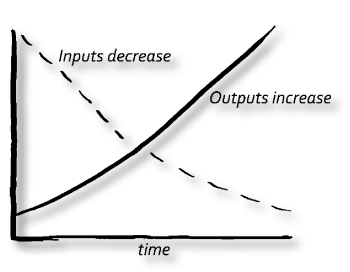
In order to decrease the inputs we can look for ways to meet these needs from within our systems. If we have a gap in our needs, they are either filled externally by work, or activity. Unmet needs can leave us with unwanted feelings and emotions and take us into a spiral of erosion.
To fulfil needs we have to design more elements into our system, replace them with elements that meet more needs or create more connections between elements.
In a family, work may be needed to care for or entertain children. There may also be an unused output of the children’s energy, that if unused can bounce around the house being a noise pollutant. In order to deal with this, a good design would consider how outputs of one part of the system can be used by another part. Can we make connections between the children where the energy of one is used to entertain the other?
This leads us to two more ecological principles:
We now have all of the components to do more thorough designs. The design process is key within permaculture, to facilitate change and turn our ideas into reality. The design web is a framework created specifically for people-based designs. It is one interpretation of the design process. This is the process we will focus on although it is not the only way of approaching permaculture designs.
It can be used for a wide variety of designs, from our own personal health to our family life, from community groups to schools, from healthcare systems to international development projects. Whoever we are designing for is ‘the client’ or ‘clients’. This may be ourselves, a family, group or organisation.
The web has 12 anchor points, each focusing on a different area to build up a detailed, holistic picture of where we want to go and how we are going to get there. The questions given here are general and open ended; they can be adapted to fit whatever you are designing.

allow yourself to dream and create goals
identify the things that are going to help
identify what blocks the path, what might keep it small or slow it down
identify helpful and unhelpful patterns
gather inspirations
look through the lens of each one
bring it all together
make a plan for getting things done
consider how to keep going
focus on things to be thankful for
evaluate progress
incorporate time for rest and rejuvenation
These anchor points can be visited in the sequence appropriate for the design. After each anchor point there are many directions you could move in. Where to go next is governed in part by what arises in each step. The design can become an intuitive movement for the designer, or a dance between the designer, the clients and the design where one step naturally leads on to another. For example you may want to capture your ideas after spending some time visioning, or exploring patterns may lead you to think about the limits.
You probably don’t know all of the answers to these questions at first; the answers may take time brewing. Your vision may be hazy at first, you may not be sure where you want to go, and so through revisiting it several times through the process you can add more detail and texture to it. You can dance in and out of stages without getting stuck waiting for something to feel complete before moving on, knowing that you can return when it feels right.
Solutions can emerge from any of the anchor points. While looking at our limiting factors it may become immediately apparent how to overcome them, or we could have inspiration from appreciation of ourselves.
Peoplecare is embedded within the process, including Pause for rest and Appreciation anchor points. Giving time and space to design is an act of support and nurturing.
The design web follows a natural pattern. Webs spread the load, catch things, make connections, are strong, light and repairable and create lots of edge. The more steps are made, the more connections and resilience the design has.
All parts of the web could be connected with each other; this is a key difference between this and linear design processes. There is a lot of scope for seeing how one part of the design influences every other. Our vision sparks ideas, limits dictate our actions, and appreciation can provide momentum. We will look in more detail at these connections in the final part.
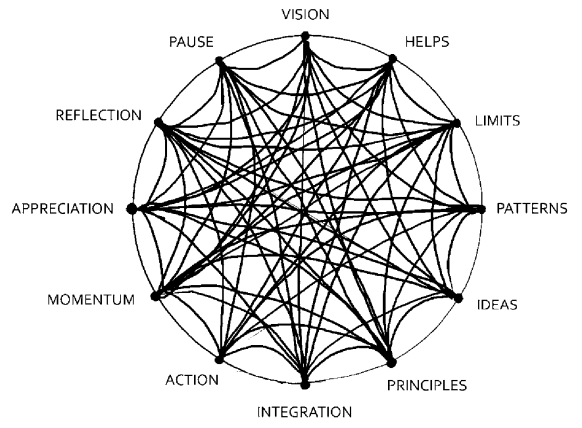
Once established, the design will catch skills and experience as well as the yields of the design itself. That is, we learn through doing and we increase our design skills for future designs, the more we reflect on the process the more we learn. Reflections can be harvested with sharing, group awareness and recording of the process.
A spider is aware of the vibrations in its web showing there is something caught. In order to make the most of our design we too need to be aware of the vibrations made. We could get so carried away with designing that we don’t notice that there is already a yield. Observation is a constant throughout.
The design web also represents systems embedded within systems. Each anchor point is a holon, a system by itself; it is also part of a bigger system, the phases, which in turn are part of the whole design.
The anchor points are in four phases reflecting the phases of life we go through as a person.
Growth phase: Vision, Limits and Helps; these are the anchor points of the child. The phase is represented by the seed, showing the potential and what is going to help or limit growth.
Exploratory phase: The next phase is of the apprentice, the young adult, learning, thinking and expressing. It is represented by the roots, reaching out, searching and exploring with Patterns, Ideas and Principles.
Productive phase: The adult stage of deciding, doing and producing is represented by the fruit, where we are looking for yields from our design in the anchor points of Integration, Action and Momentum.
Reflective phase: Appreciation, Reflection and Pause are the introspective and insightful stages of the elder, represented by the mature tree.
As well as approaching each of the anchor points as a series of probing questions there are other tools we can use to gain insights. A lot of the activities are based on the anchor points, tailored to a specific issue. You will notice that some of them have more than one anchor point symbol with them showing how the anchor points can blend or follow on from each other. We will build up our toolbox of how to use the design web and then expand on each of these anchor points in the final part. We will look at how we can use different tools and methods when designing for ourselves, with other people, in larger systems or for other cultures in the following parts, alongside a real-life design.